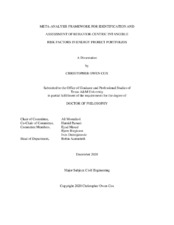| dc.description.abstract | In the oil and gas industry, it has become common to note that projects do not meet their objectives between 50 and 75% of the time, leading to adverse implications on corporate value. The Oil and Gas Authority of the United Kingdom has attributed this phenomenon to events that are nontechnical in nature, or intangible factors. Risks can be both tangible (e.g., design error) and intangible (e.g., behavior), with the emergent intangible dimension creating project complexity.
Project risk management has been an area of academic interest since the end of World War II and is a recognized methodology that enhances the probability of a successful project outcome. Current risk management assessment methods are oriented toward systems that are linear and vary from basic qualitative assessment to complex statistical analysis primarily focused on tangible project factors. Risk profiles vary as a project moves through the development cycle and include a systemic dimension for portfolios of projects. However, the implications of human behavior on project objectives are highly variable and can be “blind spots” for individuals and teams.
The goal of this research was to develop a framework to identify emergent behavior-centric intangible risks and the conditions that initiate them. The proposed framework, intangible risk assessment methodology for projects (IRAMP), utilizes a behavior-centric risk breakdown structure, risk causal factors, and a risk inducement matrix linking risks to the causal factors that precipitate them for each stage of the project development cycle. A metanetwork (i.e., a network of networks) consisting of the interactions among intangible risks, causal factors, human agents, and project tasks was modeled by the commercially available ORA-PRO software to generate network analysis measures.
This research contributes to the field of risk management in several significant ways. First, it introduces IRAMP as a new empirically based framework for the identification of behavior-centric intangible project risk throughout the development cycle. Second, it pioneers the inclusion of behavior-centric intangible risks and the conditions that cause them in a metanetwork construct, creating the ability to use dynamic network simulation models. Network analysis measures are identified for use in quantifying the implications of events and their influence on behavior-centric risks. These quantitative measures identify relationships within the metanetwork and the implications of making modifications. The ability to make the subjective objective enhances the overall effectiveness of the risk management process. | en |


